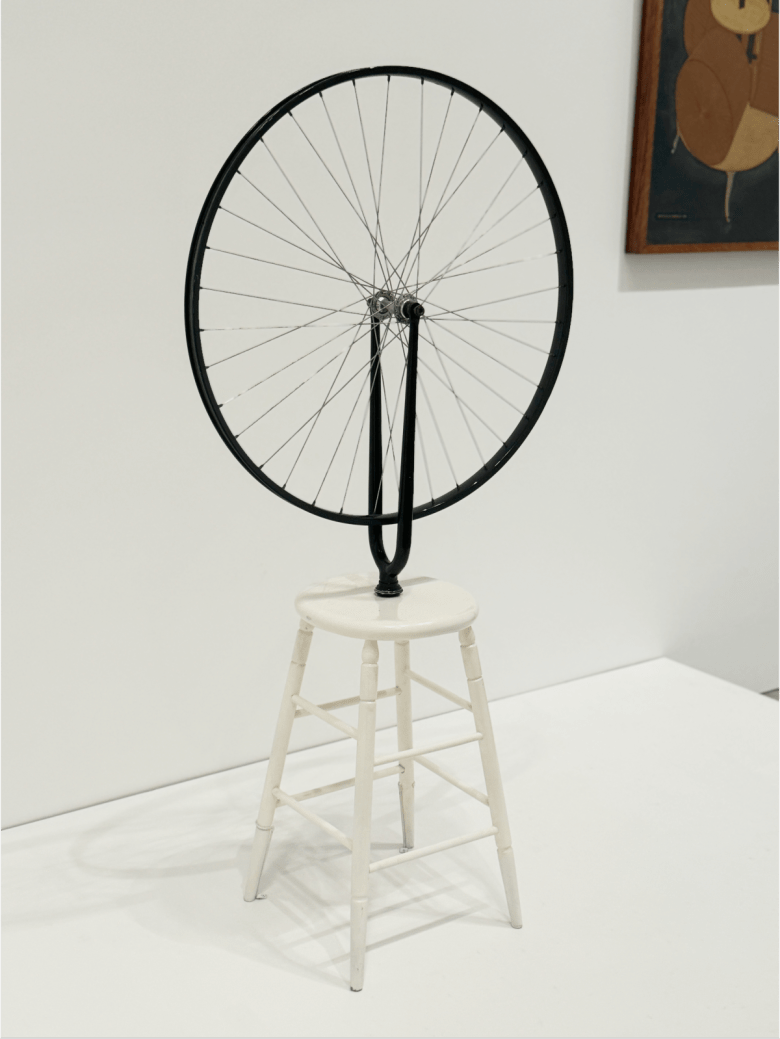In 1915, Marcel Duchamp bought a snow shovel at a hardware store in New York City. He inscribed his signature and the date on its wooden handle. Tonight, the fourth version of this classic “ready-made,” which he titled “In Advance of the Broken Arm,” will be auctioned off at Christie’s during their 20th Century Evening Sale. It’s estimated to sell for $2 million to $3 million.
How could a simple snow shovel be valued at such a steep price? Was Duchamp an unmatched genius, or a product of some of the biggest museums’ dirtiest little secrets: the results of pure, unadulterated capitalism?
Northeastern University professor, essayist, poet, and editor Eunsong Kim has illuminated the underlying influences of industrial capitalism and racism behind some of the most prized museum collections in her new book, The Politics of Collecting: Race and the Aestheticization of Property. She traces how Duchamp was brought to prominence through the patronage of collectors Louise and Walter Arensberg, heirs of a fortune wrought by the steel industry. Their family operated steel mills in the same setting as titans such as Andrew Carnegie and Henry Clay Frick, whose wealth also underlies their own valuable art collections.



And as it turns out, the “death of the author,” celebrated in conceptual art like that of Duchamp, is a convenient idea for the ultrawealthy. Devaluing labor pairs well with violent crackdowns on striking workers to deny them adequate pay. Or even Frederick Winslow Taylor’s development of “scientific management,” a system that is still cited today but is based on the idealization of the slave plantation.

How much of the Modernist archive was canonized by union-busting bosses? How much of conceptual art in the 20th and 21st centuries has been buoyed by the reverence of scientific management? In this episode, Editor-in-chief Hrag Vartanian sits down to talk with Kim about her new volume, which challenges generations of unquestioned received knowledge and advocates for a new vision of art beyond cultural institutions. In the process, they discuss the craft of writing, how a White artist was counted as a Black artist at the 2014 Whitney Biennial, and how Marcel Duchamp got away with selling bags of air.
Subscribe to Hyperallergic on Apple Podcasts and anywhere else you listen to podcasts. Watch the complete video of the conversation with images of the artworks on YouTube.












I’m not sure this thesis makes sense.
First, some of the most important works by Duchamp in the astonishing Arensberg collection were very labor intensive, no better example than Bride Stripped Bare by her Bachelors, Even, the monumental six foot tall glass panel that he worked on in his studio for seven years and required multiple materials and laborious craftsmanship. And of course with how own hand he also made paintings such as the large Nude Descending a Staircase which is widely considered a Modernist classic. No evidence in any of that work that Duchamp or his collectors were “devaluing labor.”
Second, Duchamp was hardly the only artist the Arensbergs collected and supported. Beatrice Wood was a studio potter, Jean Metzinger was a cubist painter and Charles Sheeler was an early American modernist filmmaker. All labor intensive artistic practices.
Third: The Arensbergs funded the first annual exhibition of the Society of Independent Artists New York City in 1917. Unlike traditional exhibitions of that time, it had no jury, no prize and was open to all artists. 2,500 works of painting and sculpture, by 1,200 artists, from 38 states. That’s a lot of labor!
Fourth, while Walter Arensberg and the artists he and his wife supported obviously benefited from the wealth created by his father in the steel business, he himself from an early age was a writer and poet. He labored, so to speak, on dense and artistically challenging works that created a fair amount of controversy in their time. Not quite the practice of the idle rich.
And finally, Duchamp’s ready-mades, which were an influential but small part of his overall artistic practice, were (among many other things) challenges to the notion of what is art and who gets to define it. He used mass-produced items that were made through traditional labor practices seen in the homes of or used by ordinary people. A bicycle, a bottle rack, a urinal. If a collector wanted art that devalues labor, the last work they would choose (or that an artist would choose to make) would be objects that were so clearly made through industrialized labor and in fact celebrated them as art.
Hrag Vartanian and author Eunsong Kim and commentator Samalan organize a two day conference with Hyperallergic sponsorship to meet and greet each other and promote in person collaboration promoting mutual aid and support addressing the challenges of the present with further development of artistic practice.
This run-on sentence is a real proposal. I volunteer my studio space or to find another acceptable place to meet. Oregon is less expensive than NYC but the travel costs argue against meeting here.
LA to Oregon. Easy peasy! 😉
Just do it.
KZ